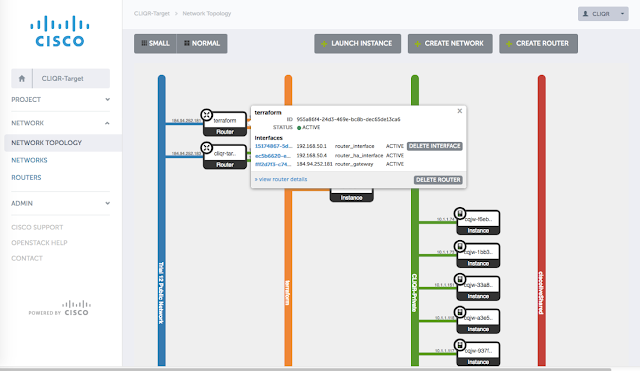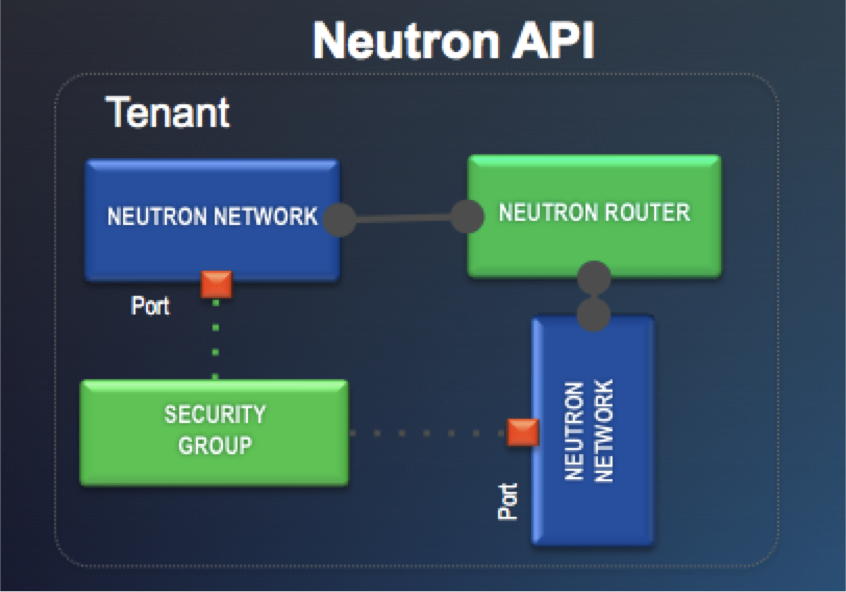Recently I worked with a customer to explore the concept of Infrastructure as Code.
They like open source solutions for the automation of the infrastructure and for managing the software applications life cycle.
To reach the first objective their goal is a private cloud based on Openstack, while they will use Ansible and Terraform to manage the environments for different projects.
Managing the Infrastructure as Code means that the definition of the infrastructure is maintained in text files, that could be stored in a version control system like you do with the source code of the application.
If you do that, the same lifecycle applies to both the infrastructure and the application: creation of staging or production environments, automated testing, etc.
Using blueprints helps to improve the quality of the final result of the project and grants compliance with policies and eventual legal obligations.
Benefits include speed, cost savings (avoiding a static allocation of pre-provisioned resources) and risk reduction (removing errors and security violations).
Terraform is one of the best open source tools to manage your Infrastructure as Code: it’s easy to install, learn and use (one hour).
You could start from tutorials and free examples available on Internet.
Here is an example of full automation (we'll try to get a little better result):
As a first step, to make the usage of Openstack easier on a large scale, we discussed the value of a managed service.
If the IT organization could just focus their effort on the development and operations of the business applications, instead of running the infrastructure, they would create more value for the internal customers (company's lines of business).
So I proposed the adoption of Cisco Metapod, that is Openstack as a managed service (delegation of all the tough administrative and operational work to a specialized 3rd party, while you just use the Openstack user interface and API enjoying a SLA of 99.99% uptime).
I have described the advantage of adopting Openstack as a managed service in this post: Why don't you try Openstack (without getting your hands dirty)?
 |
| Services offered by Cisco Metapod |
We created a lab where Openstack abstracts the resources from the physical and virtual infrastructure (etherogeneous servers, network and storage) and the configuration of different environments is managed by Terraform, so that you can create, destroy, restore and update a complex system in few minutes.
With Terraform you can describe the architecture in a declarative form (in a manifest file).
You simply describe what you need (the desired state), not how the different components (devices and software) must be configured with all their parameters and their specific syntax.
The goal of Terraform is to match the current state of the system with the desired state.
 |
| Desired State vs Current State |
Terraform is used to create, manage, and manipulate infrastructure resources. Examples of resources include physical machines, VMs, network switches, containers, etc. Almost any infrastructure noun can be represented as a resource in Terraform. Terraform is agnostic to the underlying platforms by supporting providers. A provider is responsible for understanding API interactions and exposing resources. Providers generally are an IaaS (e.g. AWS, GCP, Microsoft Azure, OpenStack), PaaS (e.g. Heroku), or SaaS services (e.g. Atlas, DNSimple, CloudFlare).
Desired State
In my lab I reused a good example that I found on GitHub at https://github.com/berendt/terraform-configurations
It contains all the resources you need to deploy a new Devstack instance (a all-in-one instance of Openstack, useful for developers) including the needed networks, public addresses, firewall rules on a target cloud platform. That, incidentally, is a Openstack instance (so we are deploying Openstack on Openstack).
Here is the content of the main.tf file used by Terraform: it references variables with the format ${variable_name}, including the output from actions on other resources. Dependencies between resources are managed automatically by Terraform. A separate file can contain the predefined values for your variables (like the references to the Openstack lab in my example).
If you are not interested in the content of this file (I guess it applies to 70% of my readers) you can skip it and go to next picture... there is also a good recorded demo down there :-)
main.tf (the manifest file where Terraform ready the desired state of all the resources):
provider "openstack" {user_name = "${var.user_name}"tenant_name = "${var.tenant_name}"password = "${var.password}"auth_url = "${var.auth_url}"}resource "openstack_networking_network_v2" "terraform" {name = "terraform"region = "${var.region}"admin_state_up = "true"}resource "openstack_compute_keypair_v2" "terraform" {name = "SSH keypair for Terraform instances"region = "${var.region}"public_key = "${file("${var.ssh_key_file}.pub")}"}resource "openstack_networking_subnet_v2" "terraform" {name = "terraform"region = "${var.region}"network_id = "${openstack_networking_network_v2.terraform.id}"cidr = "192.168.50.0/24"ip_version = 4enable_dhcp = "true"dns_nameservers = ["208.67.222.222","208.67.220.220"]}resource "openstack_networking_router_v2" "terraform" {name = "terraform"region = "${var.region}"admin_state_up = "true"external_gateway = "${var.external_gateway}"}resource "openstack_networking_router_interface_v2" "terraform" {region = "${var.region}"router_id = "${openstack_networking_router_v2.terraform.id}"subnet_id = "${openstack_networking_subnet_v2.terraform.id}"}resource "openstack_compute_secgroup_v2" "terraform" {name = "terraform"region = "${var.region}"description = "Security group for the Terraform instances"rule {from_port = 1to_port = 65535ip_protocol = "tcp"cidr = "0.0.0.0/0"}rule {from_port = 1to_port = 65535ip_protocol = "udp"cidr = "0.0.0.0/0"}rule {ip_protocol = "icmp"from_port = "-1"to_port = "-1"cidr = "0.0.0.0/0"}}resource "openstack_compute_instance_v2" "terraform" {name = "terraform"region = "${var.region}"image_name = "${var.image}"flavor_name = "${var.flavor}"key_pair = "${openstack_compute_keypair_v2.terraform.name}"security_groups = [ "${openstack_compute_secgroup_v2.terraform.name}" ]floating_ip = "184.94.252.189"network {uuid = "${openstack_networking_network_v2.terraform.id}"}provisioner "remote-exec" {script = "deploy.sh"connection {user = "${var.ssh_user_name}"key_file = "${var.ssh_key_file}"}}}
To make it simple, for this blog post I replaced the part that deploys Devstack with a simpler setup of a web server (Apache).
deploy.sh (Terraform will copy and execute it on the remote instance as soon as it is created):
#!/bin/bash# author: Joe Topjian (@jtopjian)# source: https://gist.github.com/jtopjian/4ffc82bfcbbcc78d07e4sudo apt-get updatesudo apt-get install -y -f apache2
The goal is to demonstrate how easy it is to create a new software environment on a Cisco Metapod Openstack target from scratch and run it.
The following pictures show the Metapod console before and after running the "terraform apply” command on my computer.
This is before I run the command:
 |
| The Openstack console from Cisco Metapod |
And this is the expected result (network and server infrastructure created, apache installed):
 |
| Resources created in Openstack |
Next video (the most important part of this post) is a recorded demonstration of the creation of the new Apache server: you can see the launch of the “terraform apply” command that, after reading the manifest file, creates a network, a subnet, a router with two interfaces, a floating ip and a instance on Openstack. Then the Apache web server is downloaded and installed in the new instance.
The Metapod console is left in the background and you see the Openstack objects pop up as they are created.
Finally the home page of the new web server is tested.
Conclusion
It is very easy to get rid of the delays, the misunderstandings and the inefficiency of many current IT organizations.
If you standardize the process that developers follow to obtain the environment for a new project - in all the phases of the life cycle - you can enable a faster go to market for new business initiatives making your customers happy.
It would be a first step towards DevOps (more is required, mostly in changing the culture of both developers and people in operations).
Infrastructure as code is a brilliant way to create the needed infrastructure on demand (and release it when no longer needed), to maintain it based on blueprints and manage the definition of the infrastructure with the same tools you use for the application source code: a text editor (or your preferred IDE), a version control system, an automation tool.
If you have a IaaS platform like Openstack, provisioning of both virtual and physical resources is made easy.
If you do a further step forward with a managed service, someone will grant that your Openstack is correctly configured for production, up to date and in perfect health. You enjoy all the benefits, without the hassle of setting it up and operating it daily.
References:
Using Terraform With OpenStack - https://www.openstack.org/summit/tokyo-2015/videos/presentation/using-terraform-with-openstack
Configuration to run acceptance tests for Terraform/OpenStack - https://github.com/berendt/terraform-configurations
Tutorial: How to Use Terraform to Deploy OpenStack Workloads - http://www.stratoscale.com/blog/openstack/tutorial-how-to-use-terraform-to-deploy-openstack-workloads/
Why don't you try Openstack (without getting your hands dirty)? - http://lucarelandini.blogspot.it/2016/06/why-dont-you-try-openstack.html
Why DevOps: definition and business benefit - http://lucarelandini.blogspot.it/2015/01/why-devops-definition-and-business.html
Infrastructure as Code - https://en.wikipedia.org/wiki/Infrastructure_as_Code

























